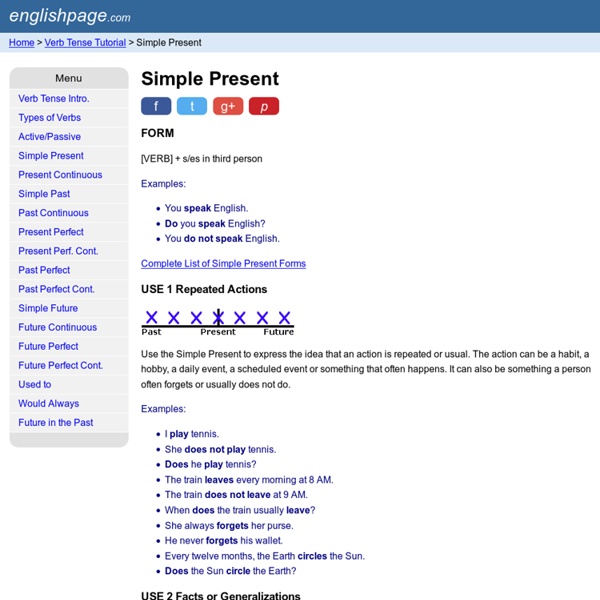Simple Present Tense:Meaning and Definition with Examples
In Simple Present, the action is simply mentioned and there is nothing being said about its completeness. It is used to talk about an action which happens on a regular basis. Notice how we use ‘study’ for the subjects I, You, We, You and They and we use ‘studies’ for the subjects ‘He’ and ‘She’. Simple Present Exercise 1 Simple Present Exercise 2 Simple Present Exercise 3 Notice how we use ‘don’t’ for the subjects I, You, We, You and They and we use ‘doesn’t’ for the subjects ‘He’ and ‘She’. Notice how we use ‘Do’ for the subjects I, You, We, You and They and we use ‘Does’ for the subjects ‘He’ and ‘She’. Simple Present Tense Exercise
Present Continuous
[am/is/are + present participle] Examples: You are watching TV. Are you watching TV? You are not watching TV. Complete List of Present Continuous Forms USE 1 Now Use the Present Continuous with Normal Verbs to express the idea that something is happening now, at this very moment. You are learning English now. USE 2 Longer Actions in Progress Now In English, "now" can mean: this second, today, this month, this year, this century, and so on. Examples: (All of these sentences can be said while eating dinner in a restaurant.) I am studying to become a doctor. USE 3 Near Future Sometimes, speakers use the Present Continuous to indicate that something will or will not happen in the near future. I am meeting some friends after work. USE 4 Repetition and Irritation with "Always" The Present Continuous with words such as "always" or "constantly" expresses the idea that something irritating or shocking often happens. She is always coming to class late. REMEMBER Non-Continuous Verbs/ Mixed Verbs
Time - Learn English Basics
Learn to talk about time and ask the time in English (requires Real Player). Time (1) When it's "on the hour" we say "o'clock". But only when it's on the hour. Time (2) In five minute increments, when it's past the hour (up to 30 minutes past) we say "past". When it's before the hour (after 30 minutes past) we say "to". There are 60 minutes in an hour. 30 minutes is half an hour, we say "half past" or "thirty". 15 minutes is quarter of an hour, we say "quarter past" or "fifteen" or "quarter to" or "forty-five". Prepositions used with time Naturally speaking Digital clocks often show the time this way using the 24-hour-clock, only the police and the military actually speak using the 24 hour clock:- How to ask the time in English. Work time There are some common words and phrases that we use to describe the hours we work. At work in the UK we talk about starting time and leaving time. 9-to-5 is a phrase used to describe a conventional and possibly tedious job. Check these time idioms too.
Present Perfect
The present perfect is a verb tense which is used to show that an action has taken place once or many times before now. The present perfect is most frequently used to talk about experiences or changes that have taken place, but there are other less common uses as well. Read on for detailed descriptions, examples, and present perfect exercises. Present Perfect Forms The present perfect is formed using has/have + past participle. Questions are indicated by inverting the subject and has/have. Statement: You have seen that movie many times.Question: Have you seen that movie many times? Complete List of Present Perfect Forms Present Perfect Uses USE 1 Unspecified Time Before Now We use the present perfect to say that an action happened at an unspecified time before now. Examples: I have seen that movie twenty times. How Do You Actually Use the Present Perfect? The concept of "unspecified time" can be very confusing to English learners. TOPIC 1 Experience I have been to France.
PRESENT SIMPLE TENSE
Present Perfect Continuous
The present perfect continuous (also called present perfect progressive) is a verb tense which is used to show that an action started in the past and has continued up to the present moment. The present perfect continuous usually emphasizes duration, or the amount of time that an action has been taking place. Read on for detailed descriptions, examples, and present perfect continuous exercises. Present Perfect Continuous Forms The present perfect continuous is formed using has/have + been + present participle. Statement: You have been waiting here for two hours.Question: Have you been waiting here for two hours? Complete List of Present Perfect Continuous Forms Present Perfect Continuous Uses USE 1 Duration from the Past Until Now We use the present perfect continuous to show that something started in the past and has continued up until now. Examples: They have been talking for the last hour. USE 2 Recently, Lately Recently, I have been feeling really tired. More About Active / Passive Forms
ROUTINES
TIME



